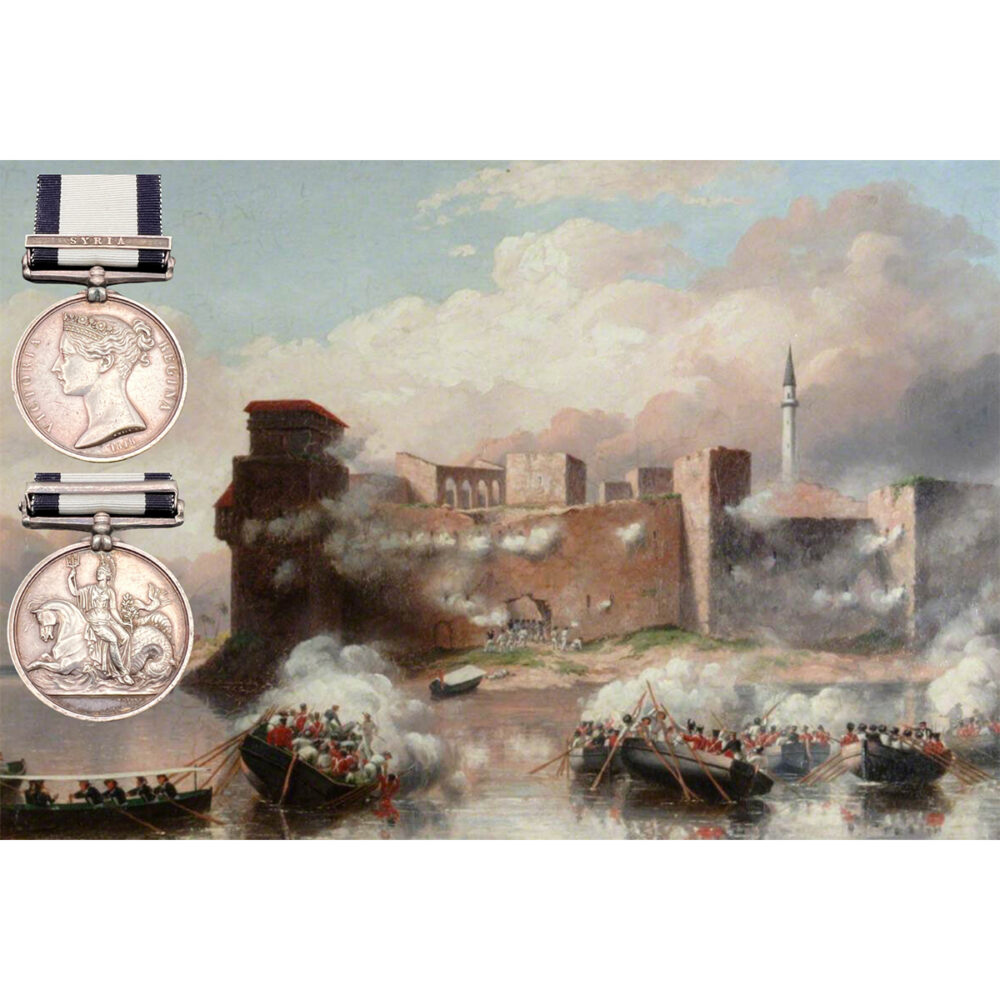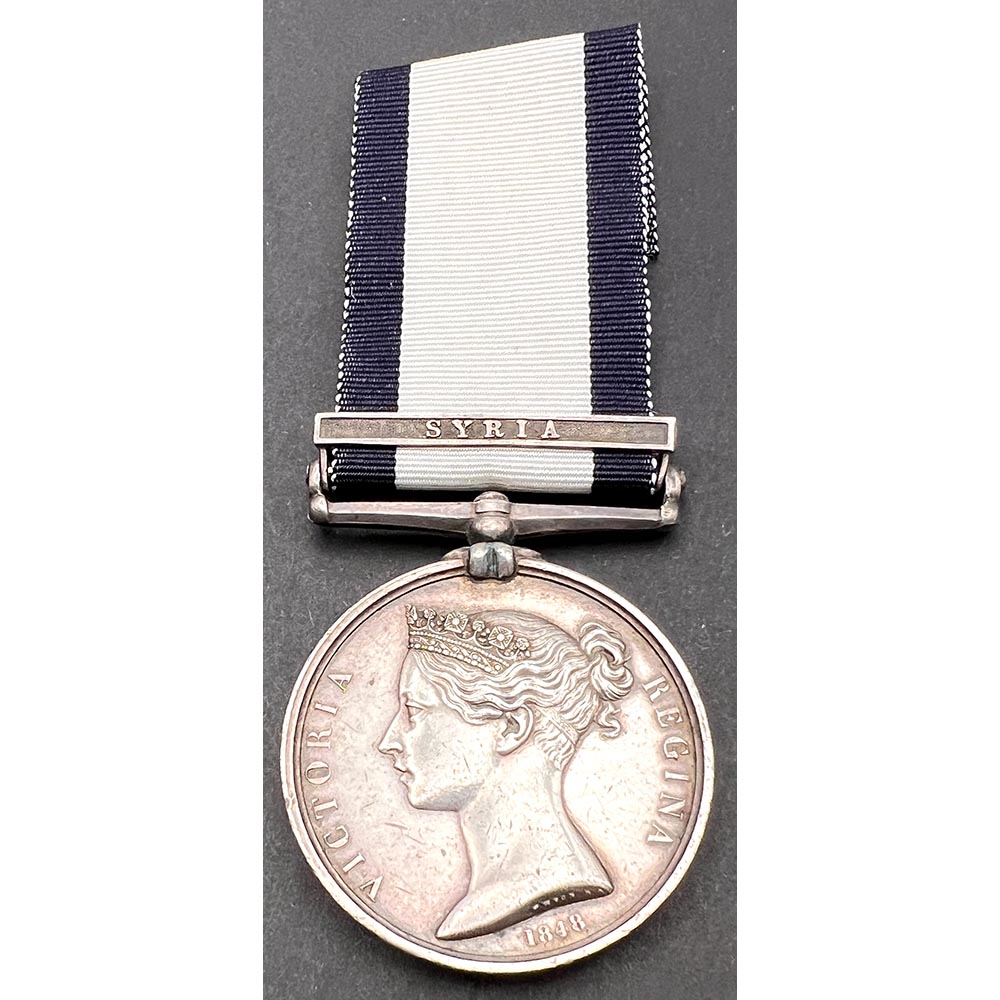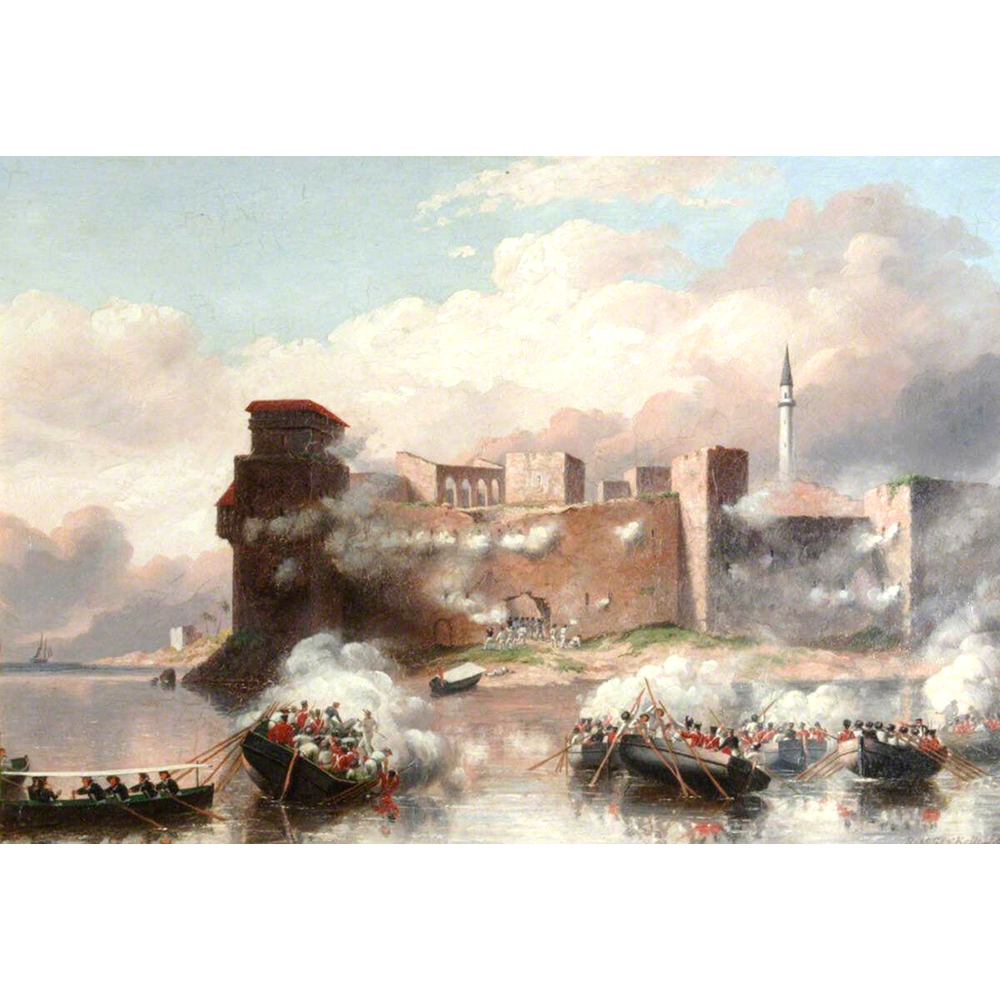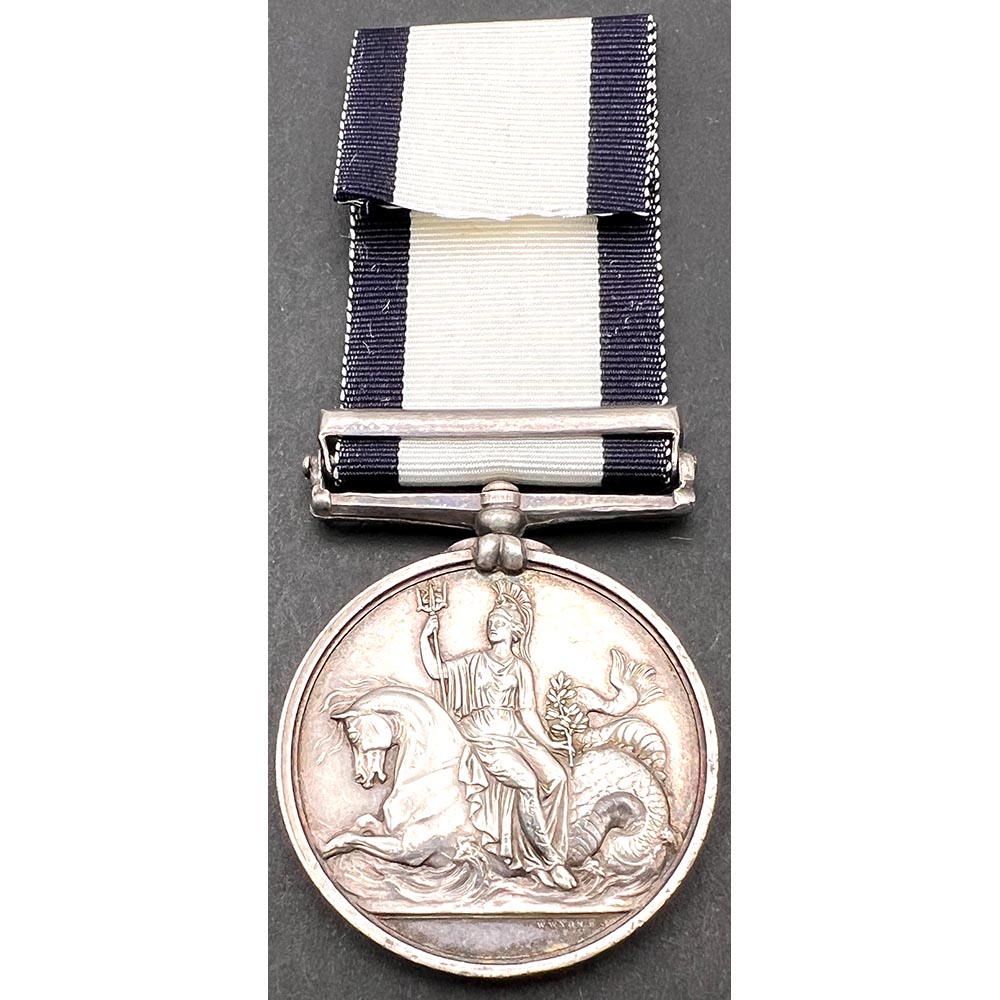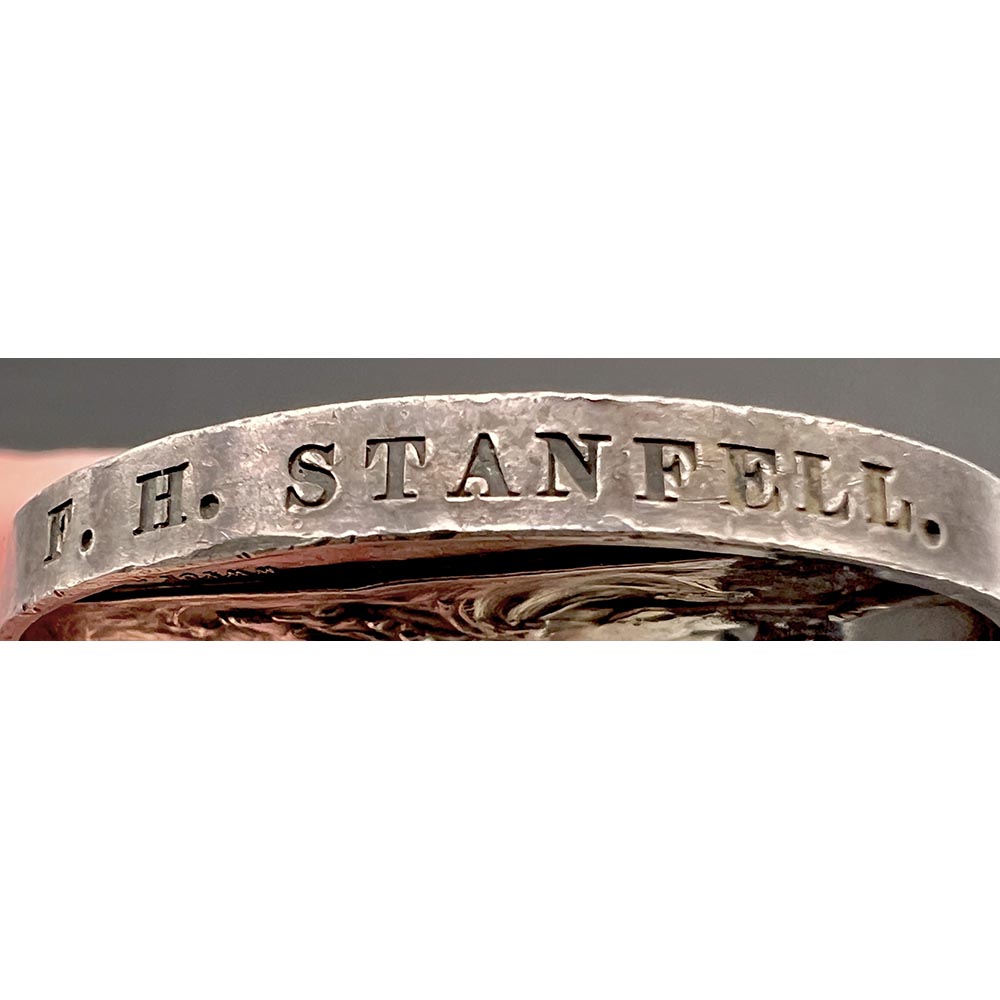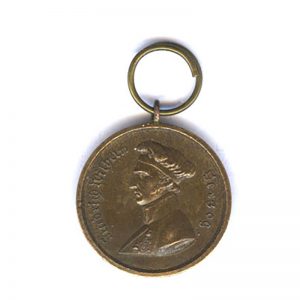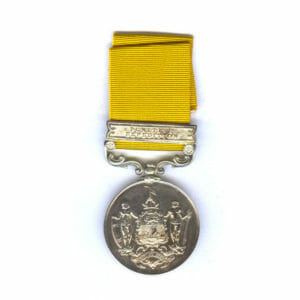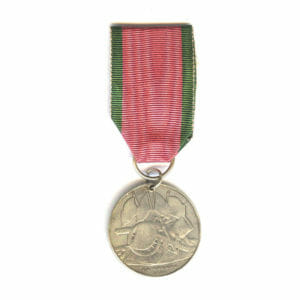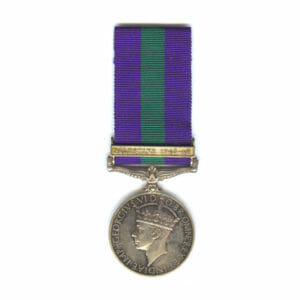Description
Naval General Service Medal, bar Syria, Commander Francis Henry Stanfell, Royal Navy, led the landing party of HMS Benbow in the raid on Tortosa, for which he was mentioned and specially promoted.
In the photograph you will see the Painting of the Raid on Tortosa, with the Landing Party boats on the way to the shore.
Close up you can see that the boats are filled with the ships Red Coated Royal Marines, with a Naval Officer, in their Blue Jackets in command, such as Stanfell.
The original painting was made by Robert George Kelly, and is now in the Royal Marines Museum, reproduced with credit to the Royal Marines Museum for education purposes and not for sale.
His service in brief from the Naval Biography up to 1849:
“Francis Henry Stanfell, entered the Navy on 4th November 1824 and passed his examination in 1831; and as a reward for his services on the coast of As a reward for his services on the coast of Syria, where he formed one of the Landing Party in the attack upon Tortosa, he was promoted to the rank of Lieutenant on 5th November 1840.
His succeeding appointments were – 15th December 1840, 27th August 1842 and 21st December 1843, to the Benbow 72, Captain Houston Stewart, The Orestes 18, Capts Hon Swynfen Thos. Carnegie, John Jas Robinson, and Edward St Leger Cannon, and the Indus 78, Capt Sir Jas Sitrling, all of the Mediterranean Station.
And on 4th February 1845 (Several months after the Indus had been paid off), to the Vanguard 80, Capts George Wickens Willes and George Frederick Rich, with whom he was for upwards of 3 years employed in the Channel and again in the Mediterranean.”
Commander Stanfell had an interesting long life at sea, setting off at just 13 as a sprightly little Midshipman, he sailed around Canada as a teen on the Flagship of the Halifax Station, HMS Hussar from 1827-1830, his log book is held in the Nova Scotia Archives for this period, she was Flagship of Admiral Charles Ogle, and had many VIPs come onboard, including Major General Sir Peregrine Maitland and anyone notable who was in need to ferrying around Canada.
Also acting as a troopship in Feb 1829, to helped move the 96th Regiment under Colonel Fullerton in Canada.
His next posting and first as a College Mate was the adventurous South America posting of HMS Samarang under the enigmatic Captain Charles Paget, where tasked with anti slavery operations around South America they had frequent run ins with Charles Darwin, on his grand surveying journey as a young man on HMS Beagle with Capt Fitzroy.
The Captain was extremely young, only about 26, but he was the son of Vice Admiral Sir Charles Paget, both father and son becoming formidable Ships Captains.
The 1st Lieutenant under Paget, was William “Billy Bun” Mclintock Bunbury, who took the opportunity of giving the open slot of a First Class Volunteer to his young cousin, an 11 year old, future famed Arctic Explorer Sir Francis “Leopold” McClintock, where he would first learn how to be a sailor, the other Officers were reportedly very kind to him, even if it was to not face the wrath of the 1st Lieutenant, his log books and drawings from the period are held at the Royal Museums Greenwich
A young Darwin recalls being entertained at dinner by the entertaining and sometimes horrifying stories of Capt Paget from their Military Service in the region, as the Beagle was on surveying duties. They also shipped home monumental amounts of money from South America, at one time passing off $880,000 to be sent home with the Clio in 1833.
Darwin’s diary entries from the period have various entries of their meetings especially when they were both stationed off Bahia Blanca in Argentina, Darwin recalls: “Capt Paget has paid us numberless visits and is always very amusing.”
Darwin recalls having Dinner with the Officers of the Samarang on their ship where he was impressed by their might as a fighting vessel, he recalls spending most of the dinner drinking with the Junior Officers such as Stanfell, “I spent most of the evening with the Mids, & such a set of young unhanged rogues the young gentlemen are.”
The full diary entry reads:
“The next morning I took a long walk and collected a great number of plants and insects, it was a fine glowing day, but it is quite delightful to find, so contrary to what I had expcted, that the heat by no means incapacitates one for exercise.
In the middle of the day I went on board the Samarang and dined there. The difference between a surveying vessel and one in real fighting order is very striking.
In the Samarang at any time under five minutes they could fire an effective broadside. I spent most part of the evening with the Mids; & such a set of young unhanged rogues the young gentlemen” are, is sufficient to astonish a shore-going fellow.”
The disastrous raid on Tortosa, occurred on the 23rd September 1840, under the Command of Captain John Ross, it comprised of 3 ship’s boats being sent as a Landing Party, of which that of HMS Benbow was led by College Mate Mr Francis Henry Stanfell, who had by his side assisting him the young Midshipman John Francis Ross (Later Rear Admiral), who was only about 19.
London Gazette, recalls the composition of the landing party:
“BENBOW, LANDING PARTY – Mr F.H. Stanfell, Mate, Mr J.F. Ross, Midshipman.
During the attack the Benbow lost, 2 Seaman and 3 Royal Marines Killed, 9 Seaman and 3 Royal Marines Severely Wounded and 1 Seaman, 1 Royal Marine Slightly Wounded.”
For his services, he was given a Special Promotion for Bravery, to the rank of Lieutenant on 5th November 1840, on a short list of men: “The Following Officers have been specially promoted for their services on the Coast of Syria.”
Medal Officially impressed: “F. H. Stanfell”.
A unique name on the medal roll, the medal was issued to him for his rank at the time as a “College Mate” aboard HMS Benbow.
Commander Francis Henry Stanfell, Royal Navy, lived from 1811-1876.
He is one of those examples that that the “The apple does not fall far from the tree”, he was born to and likely named after his father, Captain Francis Stanfell, of the Royal Navy.
His father was so well respected that his extensive entry in the Biographies of Naval Captains, directly apologises to him for: “We very much regret that is not in our power to give a fuller account of the services of such a kindhearted man, whom we likewise most highly respect.”
In brief, His father, in his young seagoing years as a Captain and Commanding Officer of various vessels, held a Turkish Gold Medal for Egypt 1801, and had captured plenty of French Privateers in the Napoleonic Wars including the un-catchable pirate who had done more damage to shipping than a combination of every privateer out of St Maloes in 2 years of good luck.
Before he set off to America, during the War of 1812, to take on during 1814 American boats unlucky enough to come across his ship HMS Bacchante.
He had married Elizabeth Barton, on 12th December 1810, who was the Second Daughter of Captain later Vice Admiral Robert Barton.
His father’s Sister, F.H. Stanfell’s Auntie, had also married James Cobb Esq, Secretary to the Honourable East India Company, who was most famous for his Operas, the “Haunted Tower” and “The Siege of Belgrade.”
FRANCIS HENRY STANFELL BORN 1811
Francis was born on 27th September 1811 in Northam, Devon. Died on 10th September 1876 in Ryde, Isle of Wight, as a retired Commander of the Royal Navy.
As your typical son of an Officer, he joined up for a life in the Royal Navy on 4th November 1824, just after his 13th Birthday.
His first currently traced ship’s posting was that as a a Midshipman for 2 years in Canada on board HMS Hussar from 1828-1830, when he was about 16.
At this time the ship was sent to the North America Station and served around Canada.
During this time he kept a Log Book of his service, which is now held by the Nova Scotia Archives as part of their British Naval papers in North America, Ref “MG 7”.
After he “Passed his Exam” after about 6 years as a Midshipman, he was appointed as a College Mate which he would serve as for 9 years on various ships, before earning his special promotion to Lieutenant, not through exams, but for his gallantry during the Syria Campaign.
He saw the following ships postings:
HMS Hussar, Circa 1827-1830, as a Midshipman in Canada.
From 23rd Feb 1827 – July 1830, the Ship was commanded by Commander Edward Boxer, employed as the Flagship of Charles Ogle on the Halifax Station, they were mostly stationed around the coast of Canada, as the Flagship it was typically used to convey important people around Canada.
Due to their useful positions on the East Coast of Canada and North America, they would also visit Bermuda, Barbardoes and Jamaica.
HMS Pearl, 2nd February 1831 to 16th April 1831, College Mate
FIGHTING THE SLAVE TRADE IN SOUTH AMERICA UNDER CAPT PAGET, BUMPING INTO A YOUNG CHARLES DARWIN ON HIS 5 YEAR ADVENTURE
HMS Samarang, 10th June 1831 – 24th January 1835, College Mate.
For this commission, she set off from Portsmouth for St Michaels under Capt Charles Paget on 26th July 1831, being paid off at Portsmouth on 24th January 1835.
An unusual tag along was the noted painter William Smyth, who did some lovely paintings whilst travelling around the Americas, and the tiny young future Arctic Explorer, Sir Francis Leopold Mclintock KCB FRS who was a boy of only 11 at the time.
During their 56,610 mile sail around South America they frequently bumped into HMS Beagle, which had Charles Darwin on board on his little journey, they stopped to have drinks and dinner where the Captain who was apparently very amusing about the current anti slavery operations and Darwin notes that he was told by the Capt “Facts about slavery so revolting, that If I had read them in England, I should have placed them to the credulous zeal of well meaning people.”
They saw a lot of service around South America, Going to Bahia by March 1832, then Pernambuco in May 1832, Settling around Rio de Janerio and Monte Video for most of the rest of 1832.
April 1833 at Rio de Janeiro, in September 1833 in the Pacific, in October 1833 arrived at Callao from the Valparasio to depart for Panama.
During this period on the Samarang, the ship was one of the most gold laden vessels afloat, the London Courier, notes that on 3rd June 1833, she had equipped the Clio at Rio de Janeiro with about $880,000 to take home to Plymouth”. The Samarang is noted as having transferred vast sums of money to be sent home at the timesama
HMS Magiciene, 20th April 1835 – 27th February 1838, College Mate
Commissioned under Captain George William St John-Mildmay and set off for Libson.
HMS Benbow, 23rd May 1839 – 14th December 1840, as College Mate
HMS Benbow, 15th December 1840, 23rd May 1842, as Lieutenant, after special promotion.
HMS Orestes, 27th August 1842 – 30th January 1844
HMS Indus, 31st January 1844 – 13th June 1844
HMS Vanguard, 5th February 1845 – 6th September 1848, invalided from ship.
HMS Royal William, 15th September 1855 – 16th November 1855
HMS Hannibal, 17th November 1855 – 20th November 1856.
Promoted to the rank of Commander on 24th November 1856.
THE FULL ACCOUNT OF THE TORTOSA RAID, SENT BY CAPTAIN OF THE BENBOW:
My attention was now anxiously turned towards Tortosa: all information concurred in representing its great importance to the enemy’s troops and all agreed in declaring that should we destroy the provisions, the troops must shift their quarters and this leave the communications with the mountains comparatively open. We were also informed that the chief breach might be made in the outer wall and immediate access obtained to them…The space from the margin of the sea to the breach, does not exceed sixteen yards. We could perceive only a few loopholes commanding that spot, and I concluded, that even should a fire be opened from them the advance from the boats would be too rapid to admit of its being effective – and that, being once within the breach, out men would easily make good their way.
Accordingly yesterday at one fifteen p.m. the Carysfort and Zebra commenced an admirably well-directed fire and very soon opened up the archway and showed us a large clear space within and the boats shoved off.
The marines were unable to land; had they done so I feel confident that we should have completely succeeded in destroying the magazines of provisions and have driven the enemy from the town, although not without loss as subsequent intelligence reached me that two hundred infantry and one hundred dismounted cavalry had entered the town the same morning, three hours before daylight.
Lieutenant Charlewood landed at once and proceeded towards the breach and had nearly reached it before a shot was fired, but the moment the large boats touched the rock, they became exposed to a destructive fire from every loop and crevice and even the holes which our cannon shot had made. Lieutenant Maitland succeeded in getting about fourteen of his men with himself landed by another turn of the same cutter. Charlewood proceeding with his pioneers broke open several stores and at length reached one filled with rice and another with corn when he immediately ran back to inform Lieutenant Maitland and get more hands forward.
Unfortunately during his momentary absence his men had hewn open another door, when, to their surprise, they found it entered upon a place filled with infantry soldiers and a struggle ensued. Two soldiers were killed by the three pioneers, but having nothing but axes they were obliged to give way, but Mr Charlewood’s return checked the enemy’s advance and they never followed him. There was no longer any prospect of success and I immediately ordered all to retire and succeeded in getting every man off.
The merits of the officers and men employed, where all did their duty, it is a difficult and somewhat delicate task to particularise. I annex a list of the boats employed with the names of officers commanding them, together with a return of the casualties in each boat.
Benbow- Landing Party.
Mr F. H. Stanfell. Mate.’
The boats from Benbow lost five killed and a further 14 wounded, in a few short minutes of ‘glorious action’.
